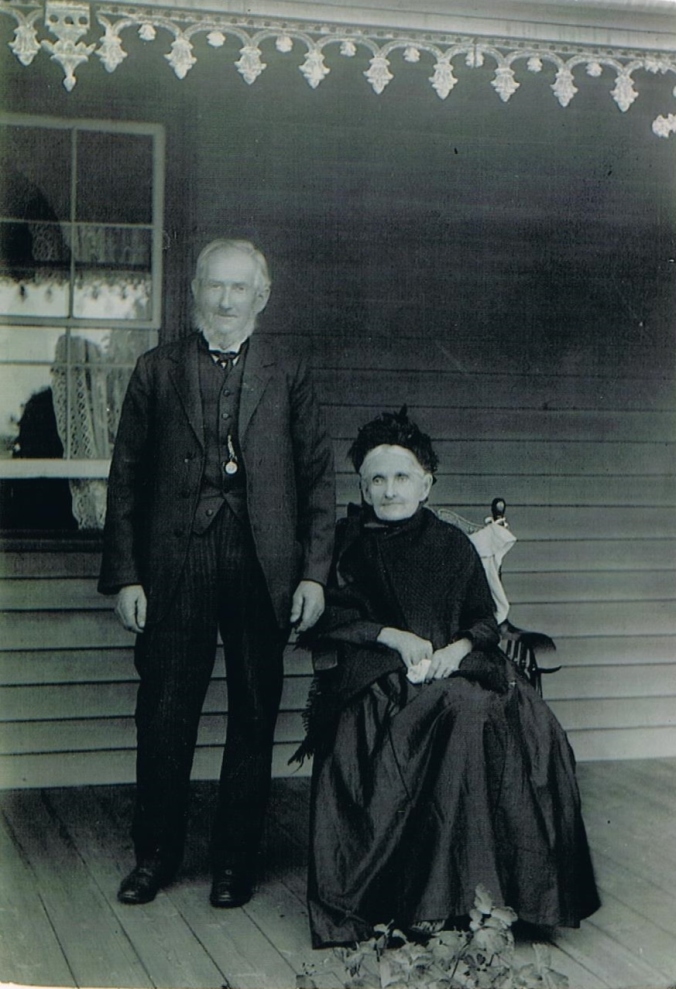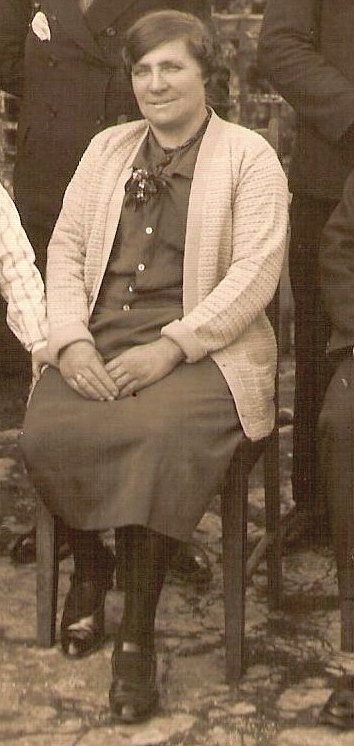I used to imagine life for my great-grandmother, Caroline Kirkin, arriving in Victoria in 1913, with husband Thomas Riddiford and five sons and the difficulties she faced as a woman in such circumstances. Hardly pioneer times, but without siblings and parents, and living in the small country town of Smeaton, north of Ballarat, she must have felt alone. She may not have had the companionship of other women at a time when she was raising small children with more on the way. In time, she would have made friends, but would that have been the same as having family to share memories of growing up in London, a long way removed from country Victoria.
I have also considered life for Susan Reed, my ggg grandmother and wife of James Harman. (below)
She arrived at Portland in 1852, a new bride at 22. As assisted immigrants, James had to work for a local property owner to repay their passage, and Susan would have been left alone. Babies began to arrive in 1854 and James would have been busy establishing a life for them. Images that would come to mind resembled a Frederick McCubbin painting.
Even Rosanna Buckland, who has led me on a merry chase, has evoked similar feelings within me. I felt for her on the treacherous voyage to Australia on the “Bombay” and then living in the “bush” at Mt William station with her husband James Mortimer.
Later in my research, when I began to investigate the siblings of these three women, my picture of their lives in Australia changed. I snapped out of my romantic imaginings to the reality that these women had a greater support system than first thought. They were definitely not alone.
Susan Read left siblings, including a brother William, at home in Melbourn, Cambridgeshire. Searching the Victorian BDM’s for Susan’s death record, using just parent names, brought up a William Reed who died at Muddy Creek, in 1889 with the same parents as Susan. I had found Susan’s brother living just down the road from her. William married Sarah Burgin in 1866 and they had seven children mostly in the Warrabkook area.
Woman of mystery Rosanna Buckland was not the only member of her family who could lay claim to the title. Rosanna had a younger sister Elizabeth, who married Richard Myhill in Berkshire in 1851. While browsing the passenger list of the “Bombay“, the Mortimer immigrant ship, I found Richard and Elizabeth Myhill also on board. Elizabeth got off the ship, but where she went after that is unknown. Richard Myhill shows up time and time again in the records and newspapers but married to Isabella Ross (1860), not Elizabeth Buckland. So at least for some part, Rosanna had the support of her sister, who may have been a welcome helping hand on the “Bombay“.
Caroline Kirkin had a younger sister Ada. Ada married Frederick Sturdy in London in 1911 and had three children by the time Caroline departed for Australia. By 1914, Ada, Frederick, and children were themselves sailing for Australia. I first found this after a search of Frederick William Sturdy at Ancestry brought up a match on the Australian Electoral Rolls. The record listed his wife as Ada Sturdy and they were living in Sturt Street, Ballarat, the same town as Caroline. How could I have not known about Caroline’s sister and her family? No-one had ever mentioned them. The Sturdys stayed on in Ballarat before moving to Melbourne sometime around the outbreak of WW2 as Frederick had enlisted.
But wait that’s not all. I was researching Caroline’s father Frederick Kirkin, who lived and died in London. He was from a family of ten children, so I proceeded to find out more about them. I knew that Frederick’s sister had married a Henry Smith, and it was another search at Ancestry which brought up a match for Elizabeth Rose Smith on the Australian Electoral Rolls in 1919 at Geelong. A search of her death record showed she was in fact a Kirkin. Elizabeth and Henry had three daughters, two I have confirmed came to Australia, but at the time I did not follow them up further. All along Caroline’s aunt and cousins were living in Geelong.
But wait that’s not all. Recently Dad told me he had thought of the two families he boarded with at Geelong as a teenager. He had talked of them in the past, by name, but names I was not familiar with. He thought maybe they were related to Grandpa, and I immediately thought of Riddiford relatives, although I thought I had them covered. I completely overlooked a possible Kirkin link. I worked back from the death and cemetery records of the couples. To my surprise, the wives of each of these families had the maiden name Smith, none other than Emily Eliza and Elizabeth May, daughters of Henry and Elizabeth Smith. They had married Fred Baverstock and Fred Harrison in Geelong. Dad had been boarding with his first cousins twice removed and did not know it.
But wait that’s not all. Whilst this research was going on, I found a UK Incoming Passenger List record for Caroline’s parents, Henry and Amy Kirkin. They had arrived in London in 1926 from Melbourne. Nothing unusual with that. They may have visited daughters Caroline and Ada and sister Elizabeth, but what was that reference to their last place of permanent residency? New Zealand? A search for people researching the Kirkin name revealed one with a New Zealand email address. I contacted him, asking if he had any clues. I mentioned a daughter, Ivy, who I had found no trace of in English records. Could she have been in New Zealand? He replied that Ivy did go to New Zealand, married and he was her grandson. His father had mentioned that Henry and Amy had gone to New Zealand on holiday to visit their daughter. He was not aware of them living there for an extended period. More research is required on Henry and Amy’s New Zealand adventure, as while they returned to England in 1926, they were on the 1928 New Zealand electoral roll. They both died in London, Amy in 1929, and Henry in 1935.
Suddenly I had Kirkin relatives in both Victoria and New Zealand. A long way from thinking that Carolyn was the only Kirkin in the Southern Hemisphere.
So with my romantic illusions shattered, I am reminded that often the lives we perceive for our ancestors is not always as it was. The more information we can gather goes a long way to creating a realistic picture of their lives. Researching brothers and sisters of direct ancestors can help fill in some of the gaps and if you are like me, the brothers and sisters sometimes led more interesting lives.
While I cannot forget the many pioneer women who did suffer hardship from isolation, not seeing another woman for months, these three women were not in that category. Aside from the arrival of a relative, in Susan’s case, she may have formed networks via the families’ strong links with the Wesleyan Methodist Church. Rosanna could have shared the company of the other station hand wives, living and working at Mount William station. Despite feeling somewhat cheated by my discoveries that Susan, Rosanna, and Caroline’s lives may not have been as I first thought, I am now compensated by having Kirkin and Read/Reed links close to home. Rosanna still owes me!



A great story about the importance of tracking the rest of the family…lots of twists and turns.
LikeLike
Thank you, I’m glad you enjoyed it.
LikeLike